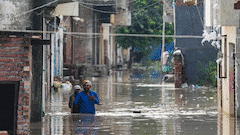Delhi Receives More Than 200% Excess Rainfall In Pre-Monsoon Season This Year
The rainfall witnessed at Lodhi Road (119.5 mm), Ridge (114.2 mm), and Ayanagar (113.4 mm) is at least 220 percent over average.

Due to back-to-back western disturbances in the previous two weeks, Delhi has received more than 200 percent more rainfall in the pre-monsoon season (March 1 to May 31). During this period, the Safdarjung Observatory, Delhi's major meteorological station, reported 221 percent higher precipitation (119 mm vs. a normal of 37.1 mm). Normally, it receives 48 mm of rain over the whole pre-monsoon season. The manual weather station at Palam reported 109.9 mm of rain, compared to the usual of 33 mm, news agency PTI reported.
The rainfall witnessed at Lodhi Road (119.5 mm), Ridge (114.2 mm), and Ayanagar (113.4 mm) is at least 220 percent over average.
For the past 15 days, Delhi has had gloomy skies and scattered rain, which is unusual for this time of year. May has traditionally been the warmest month in Delhi, with a mean maximum temperature of 39.5 degrees Celsius.
Officials attribute this to two western disturbances, weather systems that originate in the Mediterranean region and deliver unseasonal rainfall to northwest India.
Beginning May 5, another western disturbance is expected to hit the area. Cloudy skies and intermittent showers are forecast in the capital until May 7, according to an IMD spokesperson.
Until May 8, the maximum temperature is expected to remain below 35 degrees Celsius.
To the delight of its citizens, Delhi had an uncommon bout of dense fog on Thursday morning. The lowest temperature fell to 15.8 degrees Celsius, making it the third coldest May morning since the IMD began collecting records in 1901.
So far in May, the Safdarjung Observatory has recorded 45.7 mm of rainfall, according to IMD statistics. The capital receives 19.7 mm of rain each month on average.
Due to back-to-back western disturbances, Delhi received more than 20 mm of rain in April, the most in a single month since 2017.
The sustained rain has resulted in lower-than-normal maximum temperatures during the pre-monsoon season.
In reality, the Safdarjung Observatory has not documented a single hot day this summer.
This month, the IMD predicts below-normal maximum temperatures and fewer heat wave days in northwest India.
Delhi experienced its second warmest April since 1951 in 2022, with a monthly average maximum temperature of 40.2 degrees Celsius.
Last April, the city saw nine heatwave days, including four in the first ten days, the most in a single month since 2010.
(With PTI Inputs)
Related Video
Delhi News: Toxic Air Engulfs Capital as CM Rekha Gupta Alters Office Timings Amid Pollution





































